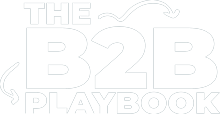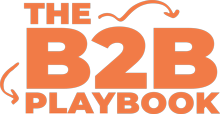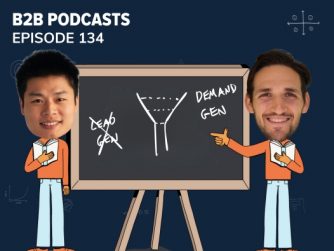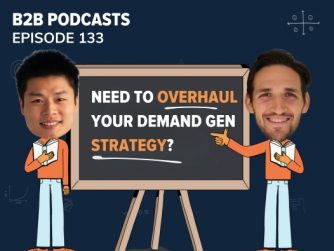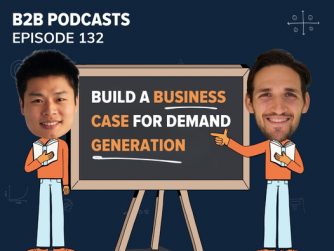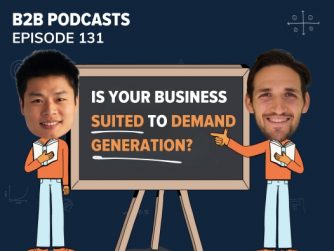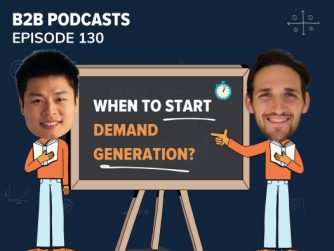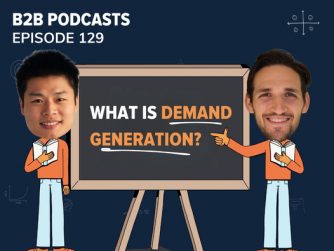Change, they say, is the only constant. This is especially true in B2B marketing and the wider advertising landscape. The changing tides of digital paid media like Google Ads, LinkedIn Ads, Meta and more present both challenges and opportunities. So Kevin and I are going to show you what’s changing, and share our own insights on how to navigate and even thrive in this evolving terrain.
Listen To The Episode
Watch The Episode
Adapting to Privacy Policy Changes
One of the seismic shifts we discussed is the impact of privacy policy changes.
“Apple’s move to limit a lot of the tracking in the name of privacy has had massive disruptions on the paid media landscape,”
[00:01:44]
This shift away from third-party tracking is redefining how we approach digital marketing, forcing us to find new ways to connect with our audience while respecting their privacy.
A few years back, Apple initiated changes limiting tracking in the name of privacy, followed by GDPR changes in Europe, causing massive disruptions in the paid media landscape. The digital marketing industry has rapidly moved away from third-party tracking, which was foundational to its measurement for the better part of the last two decades. This shift has given more control to consumers over their online data used for advertising purposes, leading major platforms like Meta and Google to alter their consumer behaviour tracking capabilities [00:02:10].
Shift in Advertising Focus and Strategies
With privacy changes affecting how platforms can track and target users, there’s been a notable shift from platforms like Meta and X (formerly Twitter) to Google search advertising. This is primarily because search advertising is driven by high intent users actively searching for specific terms or keywords.
“We know that there’s been a shift away from Meta and X when it comes to advertising. A lot of those advertising dollars actually moved away and into Google search, which appeared to survive those initial privacy changes a bit better”
[00:07:02]
This shift indicates that while social platforms face challenges due to reduced access to interest and behavioural signals, search advertising (like Google and Microsoft Ads) remains robust due to its inherent high-intent nature [00:07:30].
How You Should Respond To This Privacy Change
Yes, channels are changing because of these privacy changes – and they always will. But the key isn’t to stay on top of every little change to the platforms. It’s to align with and understand your customers and their pains as much as possible. If you understand where it is they hang out online and offline, you can infiltrate those places yourself, and you don’t have to rely on an algorithm to find them for you. If you speak to your customers, you won’t need to run A/B tests at a huge scale to what messaging will resonate – they will tell you.
Also, don’t fall for the trap of pouring all of your money into lower funnel, high-intent channels like Google Ads. If you are only operating in these channels, you are only capturing demand. And if you’re only capturing demand, you can’t scale a business sustainably as a demand generation marketer.
The Rise of AI in Paid Media and Its Implications
Artificial Intelligence (AI) is another game-changer in the paid media landscape. We got early exposure years ago to Google’s AI through its smart bidding on Google Ads. We were fortunate enough to be running accounts that spent over $20 million a year, so it had enough data to predict user behaviour, and do its job better than we could manually using the platform.
One question always bugged us though when using AI tools like Smart Bidding. This was: “if our competitors are all using Google’s AI Smart Bidding Solution, bidding for the same set of customers, then where is our competitive edge?”
“And those concerns appear to have come to fruition, creating a perfect storm for these media platforms. “
[00:05:09]
AI has made it easier than every for a low skilled marketer to get some advertising up and running. Privacy means that algorithms are more of a black box. This has resulted in more people running advertising, which means greater competition, which means it’s more expensive for everyone to run ads.
The winner? The advertising platforms.
What To Do About The Changes To Paid Media
So if advertising costs are going up, and the advertising platforms are becoming more of a black box – what should you do?
First, again make sure you deeply understand your audience and follow them. If you deeply understand them, their pains and know how to help them, then any advertising you get in front of them is not wasted. It is just one more touch point that plays an important role in the overall buying journey.
Second, hire a technical expert to help you get the most out of these platforms. If you need a hand with Google Ads or LinkedIn, click here to see how Kevin and I can give you a hand with that.
Short-Form Content and Video Marketing in Paid Media
We also touched upon the growing trend towards short-form content and the increasing importance of video in the digital space.
“There’s definitely a shift to follow that into video content. It’s a bit easier to digest,”
[00:06:48]
Given the transition to video as a preference for many consumers (likely accelerated by TikTok), you need to look at how to integrate this into your paid advertising. This is something we’ve leant heavily into and are seeing great success with.
Listening to Your Audience: The Key to Success
Perhaps the most crucial takeaway from our discussion is the importance of listening to your audience. “Follow your users, follow your audiences, follow their behaviour patterns,” as Kevin rightly pointed out [00:11:21].
There’s no magic tricks. You can’t pull a rabbit out of a hat. Go back to the framework. Listen to your dream customers, and just do what they tell you. It honestly makes you a life a lot easier.
Create Your Demand Engine in 12 Weeks
B2B marketing strategy that shows you step-by-step how to drive revenue
Understanding where your audience hangs out, what influences their buying decisions, and what content they prefer can make your marketing strategy much more effective.
Our Key Takeaways
First, there’s been a lot of changes in the paid media landscape in the last little while from the growth of short form video content to a resurgence in the importance of paid search ads.
In order to keep abreast of such changes and adapt and thrive, make sure you continue to follow those dream customers and be helpful to them wherever they are, online or offline.
And finally, you’re going be able to do this if you just keep applying our Five BEs Framework for Demand Generation, which we share step by step here on our podcast. In particular, the concepts of the circular framework that we’ve spoken about in this season. This is going to help you continue to be a marketing leader.
